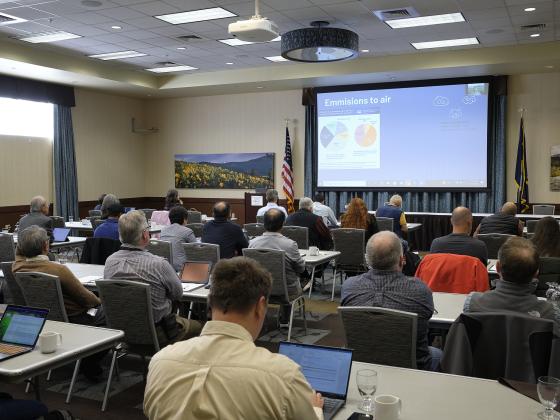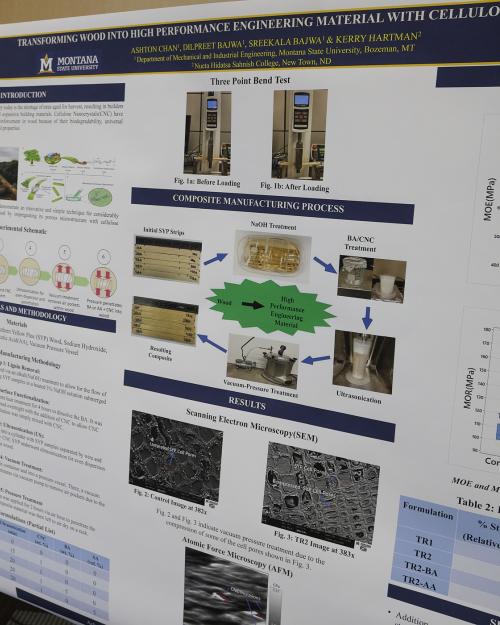Bozeman, Montana, USA
October 12, 2022

Dozens of experts from roud the world gathered in Bozeman for the 33rd annual meeting of the Association for the Advancement of Industrial Crops is an international Oct 9-12. The AAIC is a nonprofit educational and scientific organization that encourages education and research about industrial crops and products. Photo by Kelly Gorham.
Dozens of experts from around the world gathered in Bozeman Monday morning, making small talk over coffee with their international peers. They came from 11 countries -- including Portugal, Spain, Italy, Greece, Japan, Mexico, Canada, Brazil and across the United States -- to share ideas on integrating technology with industrial crops at the 33rd annual meeting of the Association for the Advancement of Industrial Crops. The conference was held Oct. 9-12.
The AAIC is an international, nonprofit educational and scientific organization that encourages education and research about industrial crops and products. Industrial crops are utilized for non-food and non-feed applications, providing raw materials and products such as energy, starch, oils, fibers and rubber that are used in different industries. This year’s conference was supported by the Montana State University Norm Asbjornson College of Engineering, MSU College of Agriculture and Montana Agricultural Experiment Station, and the U.S. Department of Agriculture National Institute of Food and Agriculture, or NIFA.
Dilpreet Bajwa, head of the Department of Mechanical and Industrial Engineering in the Norm Asbjornson College of Engineering at MSU, currently serves as president of the association. Bajwa researches biobased materials and biocomposites, with a focus on how natural fibers can be used to make composites for automotives, packaging products and aerospace applications. His research group shared in a session results of several research projects currently funded by the USDA NIFA, National Institute of Standards and Technology and the U.S. Department of Energy on how nanocellulosic materials can be used for improving fire resistance of polymer composites, energy storage capacity of salt and enhancing the mechanical properties of wood by injecting cellulose nanocrystals.
“I am very excited to host this conference in Bozeman because it gives an opportunity for the agricultural scientists and engineers working in biomaterials and biobased products a chance to showcase their research and students a chance to participate with presentations, poster sessions and meet people from all over the world who work in industrial crops,” Bajwa said. “It also showcases Montana because this is a state where a lot of fiber and oil crops, like hemp and camelina, are grown and processed.”
The conference featured keynote speakers, poster sessions and technical sessions on topics such as fiber and cellulosic crops; medicinal and nutraceutical plants; general crops; oilseeds and rubber and resins. Alison Harmon, vice president for research and economic development at MSU, delivered opening remarks, highlighting how the AAIC perfectly meshes with MSU’s land-grant mission to integrate teaching and research and engagement of stakeholders in Montana and beyond.
 A poster featuring research from Dilpreet Bajwa, head of the Department of Mechanical and Industrial Engineering at MSU, and research group. They shared in a session results of several research projects currently funded by the USDA NIFA, National Institute of Standards and Technology and the U.S. Department of Energy on how nanocellulosic materials can be used for improving fire resistance of polymer composites, energy storage capacity of salt and enhancing the mechanical properties of wood by injecting cellulose nanocrystals.
A poster featuring research from Dilpreet Bajwa, head of the Department of Mechanical and Industrial Engineering at MSU, and research group. They shared in a session results of several research projects currently funded by the USDA NIFA, National Institute of Standards and Technology and the U.S. Department of Energy on how nanocellulosic materials can be used for improving fire resistance of polymer composites, energy storage capacity of salt and enhancing the mechanical properties of wood by injecting cellulose nanocrystals.
She cited figures from a 2019 NIFA study that found the biobased industry is a substantial generator of economic activity and jobs and that it has a significant positive impact on the environment. Figures from a 2017 study suggested the industry employs 4.6 million people and contributes $470 billion to the U.S. economy, with a multiplier effect of creating another two to three jobs in other sectors for every biobased job.
“This is really important in Montana, as we are proud to be increasing the production acreage of hemp, flaxseed and camelina, and we are also home to an oilseed processing industry,” Harmon said.
On Monday, keynote speakers covered regulatory issues for growing industrial crops, using oilseed crops for renewable diesel, growing camelina, dryland farming and more. The six speakers included researchers from MSU and North Dakota State University, members of the Montana Department of Agriculture and industry professionals.
Ron Cowell from Calumet Specialty Products Partners LP spoke about the company’s project to create renewable diesel from oilseed crops. Calumet Specialty Products is a subsidiary of Calumet Montana Refining, which has a refinery in Great Falls. Along with crude oil, the refinery plans to produce renewable diesel from feedstocks, including camelina, and soybean oils. The refinery produces 12,600 barrels of renewable fuel a day with a production mix of diesel, jet fuel and naphtha, Cowell said.
Calumet uses a process called hydrodeoxygenation to create fuel. The process uses a catalyst with molecular hydrogen to break the propane “backbone” and remove normal paraffin’s. The process results in higher yields of diesel and gives off water instead of carbon dioxide, making it better for the environment.
Cowell said Calumet is in Great Falls because of its proximity to the Hi-Line and access to crops in Montana, the Midwest, Canada and other industries.
“We’re providing industrial market for the oil,” he said. “We need (Montana) farmers and ranchers to grow their products and raise their cattle. We need someone in the middle to crush the seed, extract oil and feed it to us.”
MSU professor Chaofu Lu spoke about some of the research he and his team conduct in the Department of Plant Sciences and Plant Pathology. Lu is a part of a few projects on developing camelina for sustainable production of bioenergy and biomaterials. One of his research projects received $5.1 million from the U.S. Department of Energy to take a systems-level approach to assessing camelina, focusing on yield and nitrogen use efficiency. According to Lu, nitrogen is the greatest component of energy output for camelina production. Crops can only use 30% to 50% of nitrogen applied to the field, so Lu is looking at strategies to mitigate over-fertilization.
Another project Lu touched on is funded by a $1.2 million grant from the U.S. Department of Energy’s Office of Science to understand the genetic mechanisms of camelina breeding. The idea is to selectively breed for larger camelina seeds. Typically, they are about the size of sesame seeds, but smaller seeds don't contain enough oil relative to the husk and rest of the seed. Additionally, Lu wants to improve the quality of the oil coming from the seeds. Right now, camelina oil is too high in unsaturated fat, rendering oil that is prone to oxidation and spoilage. Lu is trying to increase the oil’s proportion of oleic acid from about 15% naturally to some 80%.
Lu said the diverse audience may have already known a little about camelina and oil seeds, but the conference showed them more about the potential applications and challenges that go with them.
“This is exposure for them to see that we need to do some basic science to understand the mechanisms (of the plants) so farmers can continue to grow, and we can manage to produce a more desirable choice in the seeds,” he said.